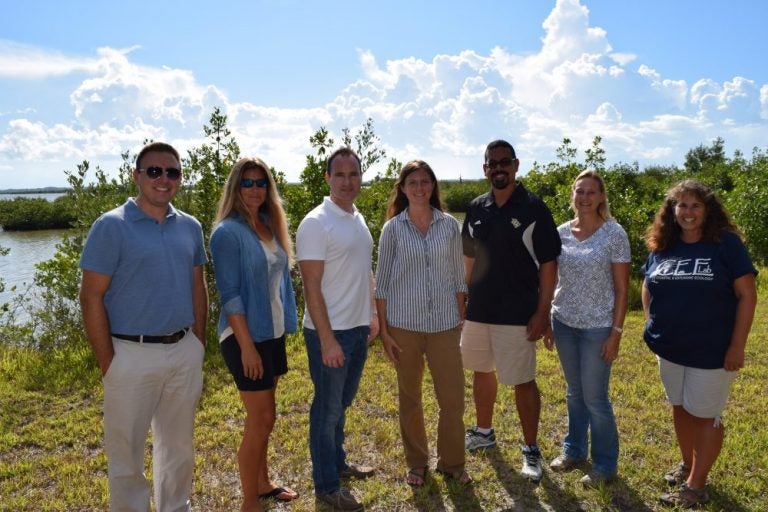A scientific answer to a challenge such as water pollution is only part of a long-term solution. For example, science may provide a way to clean water, but keeping it clean usually relies on identifying underlying causes and making a long-term impact on human behavior.
A team of UCF scientists representing the areas of biology, geography, engineering, sociology and education recently landed a $1.6 million National Science Foundation grant to figure out what makes natural systems and human interaction projects a success. They will be looking at 20 years of restoration efforts in the Indian River Lagoon in Volusia County to see if it’s made an impact beyond cleaning the waterway.
Biology professor Linda Walters, who has been working in the lagoon for two decades, is leading the team.
“Together we are going to be able to answer questions about long-term impact that will directly affect the Indian River Lagoon and will be transferable to many types of restoration projects around the country,” Walters said.
The team will use natural and social science metrics to look at that science and human interaction, while also taking into account community input in its analysis.
The three-year grant will take advantage of the extensive monitoring data for more than 80 oyster reef and living shoreline restoration projects on the lagoon that Walters has developed over a decade and which involved more than 51,000 volunteers. A comprehensive assessment of stakeholder perceptions, attitudes and sense of place within the natural system using participatory GIS and focus groups will be part of the study to determine the success of restoration efforts beyond the traditional success metrics.
For example, oysters are cleaning parts of the lagoon and have re-established colonies in several areas where they were previously lost. But what kind of long-term impact are those oysters having on erosion patterns, recreational fisheries and tourism in terms of helping keep wading birds in the area?
Another key question is what kind of impact do volunteer efforts during restoration projects have on local communities and decision makers, such as local government bodies? Do volunteers engage more in the decision-making process after working on a restoration project?
That’s where geography expert Timothy Hawthorne and sociologist Fernando Rivera come in. They will each tackle a different aspect of this question.
“We’re mapping sense of place from the public’s point of view,” Hawthorne said. “From my piece with Citizen Science (regular people gathering science data) and GIS, this project is important because it allows for residents, environmental managers, community leaders, and tourists to share their understandings of coastal restoration efforts through mapping.”
As part of his work, Hawthorne will create an online portal for the stakeholders in the Indian River Lagoon (residents, volunteers, nonprofit organizations, government agencies) to share their stories and perceptions of restoration in the lagoon.
“I have the exciting opportunity to create an online mapping portal where the public can act as citizen scientists and share data about the lagoon, about their interests in restoration, and about where they feel emotionally connected to the lagoon and current/future restoration within it,” Hawthorne said. “That’s an incredibly exciting opportunity for me as a scholar and for community members to share.”
Rivera will look at the impact restoration work has had on elected officials, public policy and the economy.
“The coupling of natural and social systems is extremely important to understand restoration efforts, particularly for a state such as Florida in which water is so vital to its social and economic livelihood,” Rivera said.
Kelly Kibler, a civil engineer, agrees. She will work with biogeochemist Lisa Chambers and the rest of the team to look at the physical environment and how it has been impacted by the restoration work. Shorelines have been restored in many areas of the lagoon with oyster beds where appropriate and with mangroves.
“The Indian River Lagoon is a very special place,” Kibler said. “In terms of biodiversity, it is an estuary of global significance. The local ecosystem services associated with the lagoon are vital to the economy of Central Florida. But like many coastal ecosystems around the world, it is sensitive to impacts of human development. To ensure that coastal communities continue to enjoy these services, it is vital that we understand the interactions between the human and biophysical systems. Through this research, we will learn about the role of environmental restoration, how it affects the ecosystem and how it affects people.”
Education professor Diedre Englehart will work with Hawthorne, Walters and others on the team to help educate the community about the team’s findings, especially with K-12 teachers and their students. Biologist Geoffrey Cook and biology post-doctoral student Melinda Donnelly round out the team providing expertise about the biology of the lagoon.
Collaborating across the natural and social sciences was key in getting funding for the project, the researchers said.
“If it weren’t for all these talented individuals who have agreed to work as a team across disciplines, this project wouldn’t be possible,” Walters said. “We are all excited and already hard at work. I can’t wait to see what we discover.”
